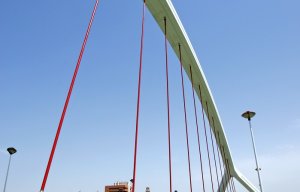
ACMA launches redesigned website
The coils used in the spacesuit are made from a shape-memory alloy ” a type of material that remembers an engineered shape.

29th September 2014
Innovation in Textiles
|
Cambridge, MA
Instead of climbing into a conventional, bulky, gas-pressurised suit, future astronauts may don a lightweight, stretchy garment, lined with tiny, muscle like coils. They would then plug in to a spacecraft’s power supply, triggering the coils to contract and essentially shrink-wrap the garment around her body.
Now MIT researchers are one step closer to engineering such an active second-skin spacesuit. Dava Newman, a Professor of Aeronautics and Astronautics and Engineering Systems at MIT, and her colleagues have engineered active compression garments that incorporate small, springlike coils that contract in response to heat.
The coils are made from a shape-memory alloy (SMA) — a type of material that remembers an engineered shape and, when bent or deformed, can spring back to this shape when heated.
The skintight, pressurised suit would not only support the astronaut, but would give her much more freedom to move during planetary exploration, researchers report. To take the suit off, an astronaut would only have to apply modest force, returning the suit to its looser form.
The team incorporated the coils in a tourniquet-like cuff, and applied a current to generate heat. At a certain trigger temperature, the coils contract to their remembered form, such as a fully coiled spring, tightening the cuff in the process. In subsequent tests, the group found that the pressure produced by the coils equalled that required to fully support an astronaut in space.
“With conventional spacesuits, you’re essentially in a balloon of gas that’s providing you with the necessary one-third of an atmosphere [of pressure,] to keep you alive in the vacuum of space,” explained Professor Newman. “We want to achieve that same pressurisation, but through mechanical counter-pressure — applying the pressure directly to the skin, thus avoiding the gas pressure altogether. We combine passive elastics with active materials.”
While skintight spacesuits have been proposed in the past, there’s been one persistent design hurdle: how to squeeze in and out of a pressurized suit that’s engineered to be extremely tight. That’s where shape-memory alloys may provide a solution, according to researchers.
To find an active material that would be most suitable for use in space, Holschuh considered 14 types of shape-changing materials, ranging from dielectric elastomers to shape-memory polymers, before settling on nickel-titanium shape-memory alloys.
The material is commonly produced in reels of very thin, straight fibre. To transform the fibre into coils, Holschuh borrowed a technique from another MIT group that previously used coiled nickel-titanium to engineer a heat-activated robotic worm.
As for where the coils may be threaded within a spacesuit, Holschuh is contemplating several designs to keep the suit tight. For instance, an array of coils may be incorporated into the centre of a suit, with each coil attached to a thread that radiates to the suit’s extremities.
As the coils activate, they could pull on the attached threads — much like the strings of a puppet — to tighten and pressurize the suit. Or, smaller arrays of coils could be placed in strategic locations within a spacesuit to produce localized tension and pressure, depending on where they are needed to maintain full body compression.

Business intelligence for the fibre, textiles and apparel industries: technologies, innovations, markets, investments, trade policy, sourcing, strategy...
Find out more